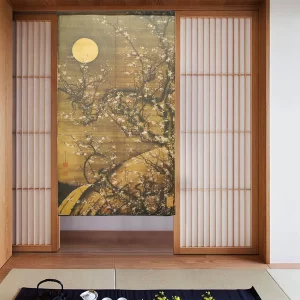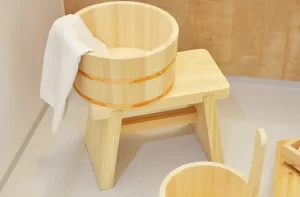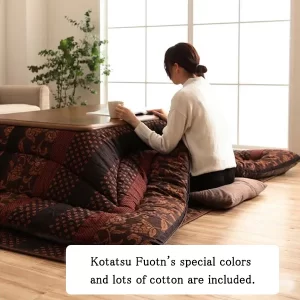Noren Wandteppich Jakuchu Ito Design
Ito Jakuchu
Jakuchu Ito war ein japanischer Maler, der während der Edo-Zeit im 19. Jahrhundert tätig war.Jakuchu, der sich das Malen selbst beibrachte und bis zu seinem Tod im Jahr 1800 im Alter von 84 Jahren malte, hinterließ im Laufe seines Lebens viele Werke.Der Reiz von Jakuchus Werken liegt in den farbenreichen, detaillierten Darstellungen, die aus seiner transzendenten Technik hervorgehen, und in der surrealistischen, fantastischen Atmosphäre.Darüber hinaus werden seine Werke manchmal als "Fantasieschule" bezeichnet und für ihre innovativen Ideen und ihr einzigartiges Gespür für Farbe und Form, die nicht an konventionelle Malmethoden gebunden sind, hoch gelobt. Zunahme.Jakuchu hinterließ viele Werke zum Thema Natur, wie z.B. Tiere und Pflanzen.Insbesondere war er gut in […]
Noren tapestry Jakuchu Ito design
Ito Jakuchu
Jakuchu Ito was a Japanese painter active during the Edo period in the 1700s.Jakuchu, who taught himself how to paint and continued to paint until his death in 1800 at the age of 84, left behind many works throughout his life.The appeal of Jakuchu's works lies in the richly colored, detailed depictions born from his transcendent technique, and the surrealist, fantastical atmosphere.In addition, his works are sometimes referred to as ``fantasy school,'' and are highly acclaimed for their innovative ideas and unique sense of color and form that are not bound by conventional painting methods. increase.Jakuchu left many works on the theme of nature, such as animals and plants.In particular, […]
Tokoname ware Kyusu Teekanne Empfohlen
Tokoname-Ware, die hauptsächlich in der Stadt Tokoname in der Präfektur Aichi hergestellt wird, hat in Japan den größten Marktanteil für Kyusu-Teekannen. Die Teekannen aus Tokoname-Keramik sind als wichtiges immaterielles Kulturgut ausgewiesen. Die Kyusu Teekanne ist ein fester Bestandteil der japanischen Kultur. Apropos Kyusu-Teekanne, Tokoname-Keramik wird empfohlen. Es gibt viele Arten von Tokoname-Yaki Kyusu Teekannen, von klassisch bis modern. Darüber hinaus ist der Tee, der in der Tokoname-yaki Kyusu Teekanne aufgebrüht wird, sehr weich und köstlich. Das ist das Geheimnis hinter der Beliebtheit der Teekannen aus Tokoname-Ware. *Klicken Sie hier für japanische Kerzenartikel Was sind die Eigenschaften der Tokoname Ware Kyusu Teekanne? Tokoname-Keramik ist eine Art von Keramik, die auf der […]
Tokoname ware Kyusu teapot Recommended
Tokoname ware, which has been made mainly in Tokoname City, Aichi Prefecture, boasts the largest market share in Japan for Kyusu teapots. Tokoname ware teapots are designated as important intangible cultural properties. Tokoname ware Kyusu teapot is an integral part of Japanese culture. Speaking of Kyusu teapot, Tokoname ware is recommended. There are many types of Tokoname-yaki Kyusu teapots, from classical to modern. In addition, the tea brewed in the Tokoname-yaki Kyusu teapot is very mellow and delicious. That is the secret behind the popularity of Tokoname ware teapots. *Click here for Japanese candle items What are the characteristics of Tokoname ware Kyusu teapot? Tokoname ware is a type of […]
Empfohlene Hinoki-Zypressenartikel für Ihr Bad
Die attraktivsten Merkmale der Badewannen, Badewannen und Stühle aus Hinoki-Zypresse sind der einzigartige Duft und die Haptik von Holz. Die Inhaltsstoffe des Duftes Hinoki Cypress wirken entspannend. Sie werden sich so entspannt fühlen, als würden Sie im Wald baden. Darüber hinaus haben die in Hinoki Cypress enthaltenen Inhaltsstoffe eine hohe insektenabweisende und bakterizide Wirkung. Es hat auch eine desodorierende Wirkung, verhindert also das Wachstum von Gerüchen und Bakterien und hält das Badezimmer sauber. Darüber hinaus ist Hinoki Cypress resistent gegen Wasser und hat eine feuchtigkeitsspendende Wirkung. Badezimmer neigen dazu, mit Feuchtigkeit gefüllt zu sein, aber die Hinoki Zypressenbadewanne absorbiert Feuchtigkeit. *Klicken Sie hier für Hinoki-Zypressenartikel Für den bequemen Gebrauch von […]
Recommended Hinoki Cypress items for your bath
The most attractive features of Hinoki Cypress baths, tubs, and chairs are the unique scent and feel of wood. Hinoki Cypress fragrance ingredients have a relaxing effect. You will feel as relaxed as if you were bathing in the forest. In addition, the ingredients contained in Hinoki Cypress have high insect repellent and bactericidal effects. It also has a deodorizing effect, so it prevents the growth of odors and bacteria and keeps the bathroom clean. In addition, Hinoki Cypress is resistant to water and has a moisturizing effect. Bathrooms tend to be filled with moisture, but the Hinoki Cypress bath absorbs moisture. *Click here for Hinoki Cypress items For comfortable […]
Traditionelle japanische Kerzengeschichte
Kerzen werden seit den Tagen der Sonnenanbetung verwendet. Es ist bekannt, dass sie um das 3. Jahrhundert v. Chr. in Europa und China existierte. Die Griechen verwendeten auch Bündel aus Papyrusgras oder Schilfblättern und Kerzen, die mit Bienenwachs oder tierischem Fett überzogen waren. Es ist ein wenig anders als die Kerzen, die heute verwendet werden, aber im Gegensatz zu heute, in einer Zeit, in der es keinen Strom gab, wurden Kerzen hauptsächlich für religiöse Zeremonien in Palästen und Tempeln als wertvolles Werkzeug verwendet, um dunkle Orte zu erhellen. verwendet wurde. Man glaubte, dass Kerzen reinigende Kräfte haben Es wird angenommen, dass das Licht von Kerzen böse Geister abwehrt, das Böse […]
Japanese traditional candle history
Candles have been used since the days of sun worship. It is known that it existed in Europe and China around the 3rd century BC. The Greeks also used bundles of papyrus grass or reed leaves and candles coated with beeswax or animal fat. It is a little different from the candles used today, but unlike today, in a time when there was no electricity, candles were used mainly for religious ceremonies in palaces and temples as a valuable tool to illuminate dark places. was used. Candles were thought to have purifying powers It is believed that the light of candles wards off evil spirits, wards off evil, purifies the […]
Kotatsu Futon Blanket, eine Tradition des Winters in Japan
In Japan ist die Kotatsu Futondecke etwas, das die Menschen vermissen, wenn das kalte Wetter einsetzt. Kotatsu Futon Blanket Mandarinen sollen in Japan eine Wintertradition sein. Der Ursprung der Kotatsu Futon Decke geht auf die Muromachi-Zeit zurück und soll eine lange Geschichte von 500 Jahren haben. Kotatsu Futon Blanket ist ein Heizgerät, das für das japanische Leben geeignet ist Warum wurde die Kotatsu Futon Blanket überhaupt in Japan geboren? Es war tief mit der Lebenswelt in Japan verbunden. Japanische Häuser wurden so konzipiert, dass sie luftig sind. Dies gilt als eine der Gegenmaßnahmen gegen die Sommerhitze, und in "Tsurezuregusa", das am Ende der Kamakura-Zeit geschrieben wurde, heißt es: "Es ist […]
Kotatsu Futon Blanket, a tradition of winter in Japan
In Japan, the Kotatsu Futon Blanket is something that people miss when the cold weather sets in. Kotatsu Futon Blanket mandarin oranges are said to be a winter tradition in Japan. The origin of Kotatsu Futon Blanket goes back to the Muromachi period and is said to have a long history of 500 years. Kotatsu Futon Blanket is a heating appliance suitable for Japanese life Why was Kotatsu Futon Blanket born in Japan in the first place? It was deeply related to the living environment in Japan. Japanese houses were designed to be airy. This is considered to be one of the countermeasures against summer heat, and in "Tsurezuregusa" written […]





